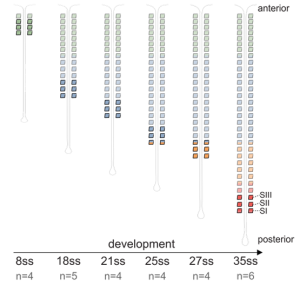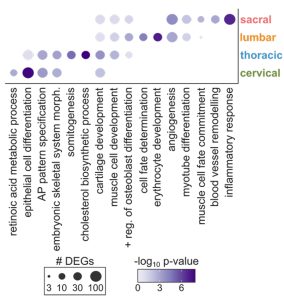A transcriptional and regulatory map of mouse somitogenesis
Posted on: 20 February 2023 , updated on: 17 April 2023
Preprint posted on 24 January 2023
Somitogenesis: common and divergent maturation programmes along the anteroposterior axis
Selected by Sergio MencheroCategories: developmental biology
Background
The vertebrate body plan undergoes a process of segmentation during embryonic development. This segmentation results in the formation of somites, which are structures that form from the presomitic mesoderm (located in the posterior part of the embryo) on both sides of the neural tube. Each pair of somites is formed rhythmically along the anterior-posterior axis following the cyclic transcription of certain genes in the presomitic mesoderm [1].
Somitogenesis has been extensively studied to decipher the identity of the oscillatory genes that drive the formation of the somites, their specification, or the establishment of the boundaries. The morphological aspect of each newly formed pair of somites is very similar. However, they are built at different times and occupy different spatial locations along the anterior-posterior axis. Ibarra-Soria and colleagues focused on understanding the spatiotemporal regulation of mouse somitogenesis by performing RNA-seq and ATAC-seq in individual, microdissected somites. The authors analysed the three most recently formed somites at six developmental stages to characterise the common aspects associated with somite formation and maturation independently of their stage as well as the differences between stages that could give insights into the spatial identity of each pair of somites.

Key findings
- Newly formed somites progress towards epithelial-to-mesenchymal transition. To understand the changes that characterise the maturation of newly formed somites, the authors performed pairwise comparisons of the three most recently formed somites regardless of their developmental stage. Genes enriched in the less mature somites were associated with the presomitic mesoderm and somite segmentation (including members of the Wnt and Notch signalling pathways), while genes enriched in the more matured somites indicated activation of adhesion and migration programmes. Changes in chromatin accessibility pointed towards the same programmes. Interestingly, most chromatin changes were associated with enhancer-like regions rather than promoters.

- Early and late somites activate different programmes according to their spatiotemporal context. Somites located at different positions along the anteroposterior axis will have a specific identity and will give rise to different derivatives. To address if these differences were already emerging in the newly formed somites, the authors compared the data obtained from different developmental time points. Gene Ontology enrichment analyses showed that somites that occupy different locations along the anteroposterior axis in the embryo have distinct functional terms. For instance, thoracic somites were enriched for genes associated with muscle and cartilage lineages while sacral somites showed an enrichment for genes involved in blood vessel remodelling. The chromatin landscape also showed extensive changes according to their developmental stage and, in this case, a higher proportion of open chromatin regions was associated with promoters.

- Somite differentiation accelerates at late developmental stages. The authors observed that the accessibility of chromatin was higher at later developmental stages as well as the expression levels of key transcription factors including members of Smad and Bmp families. They suggest that higher levels of some of these factors could be responsible for the activation of more mature programmes.
Why I chose this preprint
I am very interested in the progression of development in vertebrates and how the maturation of different tissues is regulated. I really liked the idea of using somitogenesis to address the question of how the same tissue can mature in a different way depending on the spatiotemporal context.
Also, I really appreciate the challenge of using low-input material (both from a dissection and an omics point of view) and this work encourages us to think about the questions that we can address in vivo.
Questions to the authors
- One of the most interesting results of the changes in chromatin accessibility is that the activation of the maturation programme independently of the developmental stage entails changes in distal regulatory elements. In contrast, chromatin remodelling associated with stage-specific changes affects promoter and proximal regions. Do the authors think that promoters of genes associated with the common maturation programme are already accessible since the beginning and they just need the activation of enhancer-like elements to modulate their expression and progress in the maturation cascade?
- I find it very interesting how newly formed somites at late stages seem to mature more quickly. The authors suggest that this is accompanied by a more permissive state of the chromatin (and higher levels of expression of key factors). It has been shown that the rate of somite formation slows down while development progresses [1]. Do the authors think that the fact that it takes longer for posterior somites to form could mean they have more time to undergo changes in the chromatin while being formed and, as a consequence, be more ready and able to mature faster?
References
- Palmeirim et al (1993). Avian hairy Gene Expression Identifies a Molecular Clock Linked to Vertebrate Segmentation and Somitogenesis. Cell 91(5):639-648.
- Tam (1981). The control of somitogenesis in mouse embryos. Development 65:103-128.
doi: https://doi.org/10.1242/prelights.33795
Read preprintSign up to customise the site to your preferences and to receive alerts
Register hereAlso in the developmental biology category:
Gestational exposure to high heat-humidity conditions impairs mouse embryonic development
Girish Kale, preLights peer support
Modular control of time and space during vertebrate axis segmentation
AND
Natural genetic variation quantitatively regulates heart rate and dimension
Girish Kale, Jennifer Ann Black
Notch3 is a genetic modifier of NODAL signalling for patterning asymmetry during mouse heart looping
Bhaval Parmar
preLists in the developmental biology category:
BSDB/GenSoc Spring Meeting 2024
A list of preprints highlighted at the British Society for Developmental Biology and Genetics Society joint Spring meeting 2024 at Warwick, UK.
| List by | Joyce Yu, Katherine Brown |
GfE/ DSDB meeting 2024
This preList highlights the preprints discussed at the 2024 joint German and Dutch developmental biology societies meeting that took place in March 2024 in Osnabrück, Germany.
| List by | Joyce Yu |
‘In preprints’ from Development 2022-2023
A list of the preprints featured in Development's 'In preprints' articles between 2022-2023
| List by | Alex Eve, Katherine Brown |
preLights peer support – preprints of interest
This is a preprint repository to organise the preprints and preLights covered through the 'preLights peer support' initiative.
| List by | preLights peer support |
The Society for Developmental Biology 82nd Annual Meeting
This preList is made up of the preprints discussed during the Society for Developmental Biology 82nd Annual Meeting that took place in Chicago in July 2023.
| List by | Joyce Yu, Katherine Brown |
CSHL 87th Symposium: Stem Cells
Preprints mentioned by speakers at the #CSHLsymp23
| List by | Alex Eve |
Journal of Cell Science meeting ‘Imaging Cell Dynamics’
This preList highlights the preprints discussed at the JCS meeting 'Imaging Cell Dynamics'. The meeting was held from 14 - 17 May 2023 in Lisbon, Portugal and was organised by Erika Holzbaur, Jennifer Lippincott-Schwartz, Rob Parton and Michael Way.
| List by | Helen Zenner |
9th International Symposium on the Biology of Vertebrate Sex Determination
This preList contains preprints discussed during the 9th International Symposium on the Biology of Vertebrate Sex Determination. This conference was held in Kona, Hawaii from April 17th to 21st 2023.
| List by | Martin Estermann |
Alumni picks – preLights 5th Birthday
This preList contains preprints that were picked and highlighted by preLights Alumni - an initiative that was set up to mark preLights 5th birthday. More entries will follow throughout February and March 2023.
| List by | Sergio Menchero et al. |
CellBio 2022 – An ASCB/EMBO Meeting
This preLists features preprints that were discussed and presented during the CellBio 2022 meeting in Washington, DC in December 2022.
| List by | Nadja Hümpfer et al. |
2nd Conference of the Visegrád Group Society for Developmental Biology
Preprints from the 2nd Conference of the Visegrád Group Society for Developmental Biology (2-5 September, 2021, Szeged, Hungary)
| List by | Nándor Lipták |
Fibroblasts
The advances in fibroblast biology preList explores the recent discoveries and preprints of the fibroblast world. Get ready to immerse yourself with this list created for fibroblasts aficionados and lovers, and beyond. Here, my goal is to include preprints of fibroblast biology, heterogeneity, fate, extracellular matrix, behavior, topography, single-cell atlases, spatial transcriptomics, and their matrix!
| List by | Osvaldo Contreras |
EMBL Synthetic Morphogenesis: From Gene Circuits to Tissue Architecture (2021)
A list of preprints mentioned at the #EESmorphoG virtual meeting in 2021.
| List by | Alex Eve |
EMBL Conference: From functional genomics to systems biology
Preprints presented at the virtual EMBL conference "from functional genomics and systems biology", 16-19 November 2020
| List by | Jesus Victorino |
Single Cell Biology 2020
A list of preprints mentioned at the Wellcome Genome Campus Single Cell Biology 2020 meeting.
| List by | Alex Eve |
Society for Developmental Biology 79th Annual Meeting
Preprints at SDB 2020
| List by | Irepan Salvador-Martinez, Martin Estermann |
FENS 2020
A collection of preprints presented during the virtual meeting of the Federation of European Neuroscience Societies (FENS) in 2020
| List by | Ana Dorrego-Rivas |
Planar Cell Polarity – PCP
This preList contains preprints about the latest findings on Planar Cell Polarity (PCP) in various model organisms at the molecular, cellular and tissue levels.
| List by | Ana Dorrego-Rivas |
Cell Polarity
Recent research from the field of cell polarity is summarized in this list of preprints. It comprises of studies focusing on various forms of cell polarity ranging from epithelial polarity, planar cell polarity to front-to-rear polarity.
| List by | Yamini Ravichandran |
TAGC 2020
Preprints recently presented at the virtual Allied Genetics Conference, April 22-26, 2020. #TAGC20
| List by | Maiko Kitaoka et al. |
3D Gastruloids
A curated list of preprints related to Gastruloids (in vitro models of early development obtained by 3D aggregation of embryonic cells). Updated until July 2021.
| List by | Paul Gerald L. Sanchez and Stefano Vianello |
ASCB EMBO Annual Meeting 2019
A collection of preprints presented at the 2019 ASCB EMBO Meeting in Washington, DC (December 7-11)
| List by | Madhuja Samaddar et al. |
EDBC Alicante 2019
Preprints presented at the European Developmental Biology Congress (EDBC) in Alicante, October 23-26 2019.
| List by | Sergio Menchero et al. |
EMBL Seeing is Believing – Imaging the Molecular Processes of Life
Preprints discussed at the 2019 edition of Seeing is Believing, at EMBL Heidelberg from the 9th-12th October 2019
| List by | Dey Lab |
SDB 78th Annual Meeting 2019
A curation of the preprints presented at the SDB meeting in Boston, July 26-30 2019. The preList will be updated throughout the duration of the meeting.
| List by | Alex Eve |
Lung Disease and Regeneration
This preprint list compiles highlights from the field of lung biology.
| List by | Rob Hynds |
Young Embryologist Network Conference 2019
Preprints presented at the Young Embryologist Network 2019 conference, 13 May, The Francis Crick Institute, London
| List by | Alex Eve |
Pattern formation during development
The aim of this preList is to integrate results about the mechanisms that govern patterning during development, from genes implicated in the processes to theoritical models of pattern formation in nature.
| List by | Alexa Sadier |
BSCB/BSDB Annual Meeting 2019
Preprints presented at the BSCB/BSDB Annual Meeting 2019
| List by | Dey Lab |
Zebrafish immunology
A compilation of cutting-edge research that uses the zebrafish as a model system to elucidate novel immunological mechanisms in health and disease.
| List by | Shikha Nayar |











 (No Ratings Yet)
(No Ratings Yet)